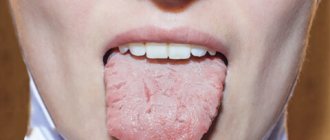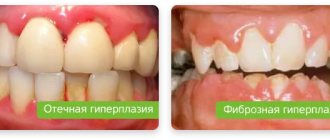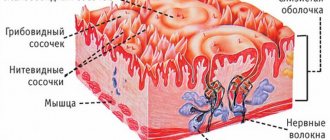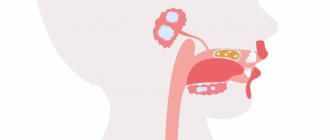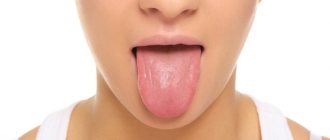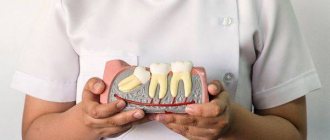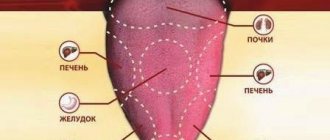The tongue has several functions in our bodies. There are thousands of taste buds on its surface, thanks to which we recognize the taste and aroma of food. But above all, it is a strong muscle with which we can speak and swallow. A healthy tongue is pink, almost smooth and elastic, and touching it should not cause pain. But if something is wrong in the body, the appearance of this muscle also changes.
What can you tell by the appearance of your tongue?
In traditional medicine, the phrase: “Show your tongue!” is usually said by a therapist and an otolaryngologist who want to examine a patient’s throat. But in Chinese traditional medicine, for more than a millennium, doctors have been diagnosing a person’s health condition by his tongue. But for maximum accuracy of diagnosis, it is recommended to examine the muscle in the morning, in good lighting, and preferably before eating and brushing your teeth.
It is interesting that even before examining the pattern on the surface of the organ, experts even pay attention to how the patient opens his mouth.
Content:
- What can you tell by the appearance of your tongue?
- Surface structure
- Color
- Plaque and possible diseases
- If your tongue hurts or burns
- What does tongue size tell you?
- What about your taste buds?
- Effect of medications on the appearance of the tongue
For example, if a person does this timidly and shows only part of his tongue, as if embarrassed, to Chinese healers this fact indicates a lack of vitality. If the patient sticks out his tongue, tilting its tip to one side, this can be perceived as a signal that there are problems on that side of the body.
According to Eastern medicine, any changes in individual parts of the organ are not an accident. The Chinese even developed a map of the relationship between individual parts of the tongue and internal organs. So, according to this theory, the language is usually divided into 5 functional zones.
Tip
This part is a “mirror” of the state of organs such as the heart and small intestine. In addition, redness on the tip of the tongue or bright spots on it may indicate anxiety or stress.
Piece by tip
By studying the state of this zone, we can draw a conclusion about the normal functioning of the respiratory and immune systems. Changes in this area may indicate bronchitis, tuberculosis, pneumonia or emphysema.
Center
The middle part of the tongue informs about the functioning of the digestive system, in particular the stomach, pancreas and spleen. Redness or yellow spots in this area indicate gastrointestinal diseases. Any changes in the central part may also be a sign of problems with stool: diarrhea or constipation.
Right and left side
These areas reflect the condition of the liver. If the sides of the tongue are swollen, this may be a signal of hepatitis or fatty liver disease. Sometimes such changes appear in people with diabetes or flatulence. Dark spots around the edges sometimes appear in the presence of cirrhosis or liver cancer.
Back (back)
Any changes in this area may indicate renal failure, bladder dysfunction, dysfunction of the gonads, or disruptions in the endocrine system. In particular, a yellow coating on the back may indicate an infectious disease of the bladder, other changes may indicate urethritis or kidney disease.
Diagnosis of glossitis
If glossitis is accompanied by severe symptoms, the dentist can understand the cause of the disease after the initial examination.
To clarify the diagnosis, the following diagnostic methods will be required:
- Donating blood for general and biochemical analysis. This will confirm the presence of inflammation and assess its intensity.
- Donation of saliva to identify the infection in it that caused the inflammation.
- Ultrasound of the digestive system.
If an accurate diagnosis cannot be made, the patient is prescribed additional examinations:
- RPR test to detect antibodies to cardiolipin antigen.
- Scraping from the tongue with its further microscopic examination.
- Cytological analysis.
- Serological tests for syphilis.
- ELISA for antigen detection
- Blood test to determine vitamin B12 levels.
When the diagnosis is clarified, the doctor will prescribe the necessary treatment to the patient.
Glossalgia and glossitis are two different diagnoses. With glossalgia, the root of the tongue becomes inflamed, but the tip remains untouched. Pain also occurs precisely in the root part of the organ.
Surface structure
If cracks have formed on the surface of the tongue, this usually indicates dehydration and excessive blood thickening, which, in turn, increases the risk of stroke or thrombosis. Also, a dry surface with numerous small cracks is one of the symptoms of diabetes. But depending on their location, cracks can indicate different diseases. For example, one deep one in the middle of the tongue can be a symptom of an upset digestive system and high acidity in the stomach.
A spotted or raised tongue may indicate that a person has fungal infections, vitamin deficiency or allergies.
Sometimes such changes appear in people with vitiligo or psoriasis. But if a curved line is clearly visible on the surface, then the musculoskeletal system should be checked; this may be a signal of a spinal disease.
Comments
At what age do people usually get Günther Müller's glossitis?
Vladimir (01/30/2021 at 11:57 pm) Reply to comment
- This type of glossitis, in fact, like all others, can develop in patients of any age, but people who have chronic diseases, pathologies of the gastrointestinal tract, and smokers are always at risk.
Editorial staff of the portal UltraSmile.ru (02/05/2021 at 09:16) Reply to comment
It turns out that our tongue can say a lot about the body, it’s not for nothing that doctors always ask to see it, even if they just came for a medical examination. Can any age have these diseases or older people?
Maria (02/05/2021 at 07:32) Reply to comment
I wonder what is better to eat to avoid such serious problems? It seems to me that a lot depends on food. Against the backdrop of abundance, you begin to not understand what is useful and what is not.
Marina (02/05/2021 at 08:20) Reply to comment
I once had glossitis, about five years ago. Although I don’t smoke, don’t drink, I lead a healthy lifestyle. Before this I had a sore throat. What folk remedies do you recommend that are the most effective?
Irina Frolova (02/05/2021 at 09:40) Reply to comment
Hello. I developed glossitis due to candidiasis. The tastes are very dull. Everything seems to have been cured, but I don’t feel the same brightness from food. Please tell me, can something be done about this or is it forever?
Vera (03/04/2021 at 10:56 am) Reply to comment
Since childhood, all doctors have told me “geographical language.” It has some stains and a yellow-green coating. Is this a disease or not? It just doesn't bother me the way it feels. But it's not very easy to clean.
Vladimir (03/04/2021 at 11:38 am) Reply to comment
Write your comment Cancel reply
Color
A healthy person's tongue should be slightly pink. Any changes in color can be regarded as a signal of health problems.
Crimson or violet-tinged
The tongue may acquire this color due to an excessive increase in body temperature caused by inflammation or an infectious disease. Blueness of the tongue often indicates hypoxia (impaired blood supply), and a purple tint sometimes appears after eating too spicy foods.
Scarlet
In people who have a poor diet or are obese, the middle part of the tongue may be bright red. Similar symptoms appear with gallbladder diseases or blood stagnation. If redness is visible on the tip of the tongue, this may be a sign of chronic stress, cardiac disorders, or insomnia and neuroses. If the tip of the tongue is bright red and slightly swollen, there is reason to believe that the person is suffering from coronary heart disease. Additionally, red spots on the surface may be a sign of B vitamin deficiency.
If the tongue is not just bright red, but also completely smooth, this indicates liver disease, toxin poisoning, as well as a lack of vitamin B12 and iron, since this mineral is necessary for the formation of papillae on its surface. By the way, this type of tongue can be seen in vegetarians. But if a person eats a more or less balanced diet, but his body still lacks vitamins, perhaps the reason is an autoimmune disease, due to which nutrients are not absorbed. And this can also be suspected by the unnaturally red and smooth tongue. In some cases, a smooth, very red surface may be the result of a burn or overuse of hot spices. Red spots on an unnaturally pale surface are a signal of disturbances in the respiratory system. A scarlet and grainy tongue most often indicates scarlet fever.
Very pale, almost white
Such an anomaly may indicate several serious diseases. The tongue turns pale at very low body temperatures, due to anemia, a weakened heart, or when the immune system is impaired.
Black
A very dark, almost black tongue always indicates kidney dysfunction. In addition, it does not matter in which particular zone the dark spots appeared, although most often in such cases the base of the tongue turns black.
White spots on the mucous membrane
Sometimes painless white spots may form on the tongue (bottom or along the edges). Medically they are known as leukoplakia. They are formed as a result of excessive cell growth. Smokers often have such spots. And in this case, this is a very alarming signal. Leukoplakia is called a precancerous condition. Between 5 and 17% of people with these spots eventually develop cancer. However, if you quit smoking in time, the spots will disappear. If such spots appear in non-smokers, then perhaps their cause is banal rubbing of the tongue by the teeth. But if leukoplakia does not go away, you should consult a dentist to solve the problem.
Treatment of glossitis
Treatment of different forms of glossitis may have specific nuances. The duration of therapy is influenced by the type of disease, severity, and characteristics of clinical symptoms.
Regardless of the form of glossitis, it is first necessary to eliminate the mechanical and chemical causes of the disease. First professional aid will be provided by a dentist. He will treat carious teeth, adjust dentures, check the condition of crowns, and adjust braces.
For complete treatment of glossitis in adults, it is necessary to use a whole group of drugs, which are selected based on the type of pathogenic pathogen:
- Antiseptics.
- Antifungal or antibacterial.
- Painkillers.
- Anti-inflammatory.
- Reparative - necessary to stimulate the process of keratinization of the epithelium.
Additional vitamin therapy with vitamins A and E enhances the effect of drugs aimed at regenerating damaged tissues.
List of drugs used in therapy
Medical products (medicines, vitamins, medicines) are mentioned for informational purposes. We do not recommend using them without a doctor's prescription. We recommend reading: “Why can’t you take medications without a doctor’s prescription?”
Antiseptics
influence protein coagulation and oxidation mechanisms in the pathogen cell. These mechanisms inhibit the proliferation of bacteria and their further death. Fungi, gram-positive and gram-negative microorganisms, viruses are not resistant to most complex broad-spectrum drugs. Medicines in this group have an antiseptic, anti-inflammatory, and analgesic effect.
List of drugs that can have a disinfecting effect:
- Solutions:
Chlorhexidine, Chlorophyllipt, Furacilin, Borax solution, Methylene blue.
- Spray:
Hexasprey, Lugol-spray, Tantum Verde.
- Gels:
Kamident, Metrogil Denta.
- Pills:
Hexalize, Hexoral.
Anti-inflammatory drugs
inhibit the activity of cyclooxygenase and the synthesis of prostaglandins, which support the inflammatory response. Sprays, gels, solutions for rinsing and applications have a local anti-inflammatory and anti-edematous effect. In addition, drugs in this group help restore normal blood microcirculation.
Antifungal agents.
If a patient is diagnosed with fungal (candidal) glossitis, the tongue is first treated with antiseptic compounds, and then ointment (Candida or Pimafucin) is applied. For oral administration, Fluconazole, Nystatin, and Diflucan tablets are used.
Antibiotics.
Antibacterial drugs are not often prescribed for glossitis. Any antibiotics can be used only after consulting a doctor. They are used for purulent glossitis, or for phlegmonous inflammation. They allow you to destroy bacteria and lead to a full recovery. Most often, drugs are used in tablet form: Amoxiclav, Suprax, Cefodox.
Anesthetic drugs.
If the pain is very severe, the patient is prescribed painkillers. They contain novocaine or lidocaine. Such products are available in the form of sprays and gels. They are used for local application.
Hormonal ointments (Hydrocortisone or Prednisolone) can be used for a short period of time. They help prevent the development of death of tongue tissue.
Wound healing ointments.
In order for damaged tongue tissue to recover faster, the patient is prescribed ointments that accelerate cell regeneration. This could be Solcoseryl, Olazol, Carotiline.
Immunomodulatory drugs.
To increase the body's defenses, drugs such as Viferon, Leukinferon, Kipferon, Interferon alpha, Imudon, Immunoglobulin are prescribed.
Antiviral drugs.
For herpetic glossitis, oral antiviral medications will be required. This could be Gerpevir, Acyclovir, Cycloferon.
Multivitamin
complexes
, including vitamins PP and group B, can influence the focus of inflammation, stimulate local metabolism in tissues, and restore damaged cells. Active compounds restore redox mechanisms and expand the lumen of blood vessels.
If a person suffers from pain in the mouth that occurs due to drying out of the mucous membranes, then it is necessary to treat them with glycerin and anesthesin. These components are pre-mixed with each other.
Treatment of catarrhal form
The catarrhal form of glossitis most often develops in adult men who abuse smoking. Symptoms of the disease appear and progress in people who often consume spicy foods and alcoholic beverages. With appropriate therapy, uncomplicated catarrhal glossitis is completely cured within a week.
Is it possible to cure catarrhal glossitis at home? Yes, this form responds well to treatment. The main recommendations are to rinse your mouth with an antiseptic solution after each meal. If the inflammation is focal in nature, it is advisable to perform applications.
For rinsing, you can prepare decoctions from medicinal plants, which are known for their antiseptic properties:
- Chamomile.
- Basil.
- Coltsfoot.
- Coriander.
- Sage.
- Bedstraw.
- Calendula.
If the patient complains of constant dryness of the oral mucosa, oregano and yarrow are recommended, which promote abundant salivation.
The treatment procedure involves more than just rinsing the mouth. Use a cotton or gauze swab dipped in a decoction or solution to remove plaque formed on the mucous membrane. After cleansing, a healing gel is applied to the surface. Regular implementation of therapeutic procedures can completely eliminate all symptoms of inflammation.
To more quickly restore the mucous membrane of the tongue and maintain the result, the patient must adhere to certain nutritional recommendations:
- Give preference to pureed dishes, porridges, puree soups, vegetable, fish, and meat soufflés.
- The optimal food temperature is not higher than 40°C.
- During treatment, avoid hot, spicy, sour foods, alcohol, carbonated drinks, and coffee.
Treatment of candidiasis
If it is determined that the cause of glossitis is a fungus, then the treatment is subject to some adjustment:
- All antibacterial and corticosteroid drugs are canceled.
- Treatment of concomitant pathologies is carried out.
- Adaptogens, vitamins, biostimulants, bifidumbacterin are prescribed to restore the body's protective functions and improve general condition.
- Eliminate foods rich in carbohydrates from your diet.
Treatment regimen for mild forms.
To suppress mild candidiasis, treat the oral mucosa with a 2% solution of sodium bicarbonate (baking soda), iodinol, and aniline dyes. Be sure to irrigate the lesions with antiseptics that have a fungicidal effect, nystatin (1-2 tablets per 5 ml of milk). All manipulations are performed until the mucous membrane is completely restored. If all the patient’s complaints have been eliminated, treatment is continued for another seven days, gradually reducing the number of procedures.
Treatment regimen for moderate forms.
Requires the appointment of Nystatin ointment, gels, aerosols with Clotrimazole, and special antifungal chewable tablets. After treating the affected area of the mucosa, antifungal compounds practically do not penetrate into the bloodstream. Local antimycotic drugs are used for 2-3 weeks. After all symptoms of the disease have passed, treatment is continued for another 7 days.
Treatment regimen for severe forms.
If the disease progresses, antifungal drugs are taken orally.
Complex treatment is carried out in a hospital setting with the mandatory appointment of:
- General strengthening complexes.
- Immunomodulators.
- Antiallergic drugs.
- Probiotics.
Treatment regimen for chronic form.
Chronic glossitis does not respond well to local antifungal therapy. Antimycotics are not able to be absorbed into the deep layers of the mucosa, and therefore do not have the proper effect on foci of fungal infection. A positive effect is possible only after repeated courses of taking specific drugs orally.
An integrated approach implies:
- Conducting a course of restorative medications;
- Restoration of physiological intestinal microflora;
- Immunocorrection;
- Treatment of the underlying disease;
- Antiallergic therapy.
Complete oral hygiene is ensured by antifungal toothpaste, for example, President Exclusive. Sweet foods and drinks are excluded from the usual diet. Regular consumption of fermented milk products enriched with bifidobacteria is mandatory. The patient should receive large amounts of proteins and vitamins.
Treatment of desquamative form
The basis of therapy is complete care for the condition of the oral cavity. Complex therapy consists of a number of activities:
- Treatment of dental diseases.
- Consultation with a therapist to determine concomitant somatic disorders and restore normal functioning of the gastrointestinal tract.
- Elimination of the infectious focus with the help of antiseptics.
- Restoration of normal mucous membrane.
- Prescription of adaptogenic, multivitamin preparations.
- Antiallergic treatment.
- Taking sedative herbal medicines.
Treatment of folded form
The development of folded glossitis is an irreversible process. Treatment is prescribed if the patient has complaints.
If signs of inflammation appear, the following recommendations should be followed:
- Rinse your mouth with antiseptic solutions after each meal. Folds are treated with chlorhexidine, 3% hydrogen peroxide solution, chamomile or calendula decoctions, and miramistin.
- Perform applications with regenerating, enzymatic agents.
- Periodically undergo a course of laser therapy of 5-10 sessions.
The listed measures contribute to the complete removal of dead epithelial cells and restoration of the mucous membrane. If treatment of the underlying disease requires the use of corticosteroids or antimicrobial drugs, the patient is regularly examined by a doctor. This is necessary for the early detection of candidal lesions. In this case, irrigation with antifungal solutions and aniline dyes is prescribed.
Treatment of diamond shape
If the patient does not have any complaints, specific therapy is not required. If symptoms of inflammation appear, an integrated approach is necessary:
- To give up smoking.
- Examination of the oral cavity, elimination of possible etiological factors.
- Mouth rinse and local applications with antiseptic solutions.
- If the fact of a fungal infection is established, specific anti-candidiasis drugs are prescribed.
- If necessary, use sedatives and tranquilizers.
In case of tissue proliferation with tubercular or papillomatous glossitis, surgical intervention is necessary.
Plaque and possible diseases
During normal functioning of the body, the human tongue is covered with a thin, loose layer of whitish plaque. If it changes color or thickness, this is already an alarming signal.
White
A dense white coating can appear as a result of hypothermia or a slowdown in metabolism (this often happens in the fall). If the plaque is uniform, but very thick, this indicates the presence of a bacterial infection in the body, and if it forms lumps, this is a signal of a fungal disease.
A thick layer of white plaque also occurs with chronic gastritis with high acidity or enterocolitis. With gastritis with low acidity, the plaque is not as thick and drier. It is also interesting that by the thick white coating on the tongue you can recognize those with a sweet tooth and lovers of dairy products.
Grey
Gray plaque is a sign of infectious diseases accompanied by fever. Also, a grayish coating may indicate diseases of the gastrointestinal tract or liver. In particular, the tongue may acquire a grayish tint during an exacerbation of peptic ulcer disease. If a gray coating appears in the company of small blisters on the tongue, the person may be suffering from herpes. A grayish coating can also signal that the body lacks iron.
Brown
Most often, a tongue with a dense brown coating can be seen in smokers. The same symptom indicates disturbances in the respiratory system, which can lead to hypoxia. Also, brown plaque is a signal of digestive problems.
Yellow
If such a plaque appears in a person in the summer, this may indicate overheating of the body. The surface of the tongue also turns yellow after drinking coffee or certain spices. In more serious cases, the appearance of yellow plaque indicates a gastric ulcer, malfunction of the pancreas or liver.
Greenish
Plaque with a green tint is a very alarming signal. As a rule, it warns of serious liver diseases, including the development of cancer.
The main reasons for the development of pathologies
Many people ask questions about how and how to treat glossitis of the tongue. But, as we noted above, before prescribing a set of therapeutic measures, you first need to find out what form of pathology the patient has and what exact reason it is caused by.
| Oral problems | Diseases of the body | Related factors |
|
|
|
Do you think you have glossitis of the tongue and don’t know what to do? Even minor symptoms of pathology and slight discomfort are a reason to consult a doctor who will conduct a comprehensive examination (examination, smear or scraping, blood tests and LBC culture, histology), make an accurate diagnosis and prescribe treatment.
If your tongue hurts or burns
In many cases, painful sensations in the tongue appear as a result of not following a balanced diet. In particular, pain can occur due to a lack of iron, vitamins B6, B3 (PP) and B12.
A burning sensation on the surface of the muscle may indicate that the stomach is producing too few digestive juices, so this symptom usually indicates a malfunction of the gastrointestinal tract.
Sometimes, if the tongue looks no different, but there is a burning sensation, this may indicate a hormonal imbalance. By the way, women experience this symptom almost 7 times more often than men. In addition, the burning sensation may be the result of an allergy to the wrong toothpaste.
Prevention
Prevention of these diseases includes several rules :
- It is necessary to provide high-quality dental care and visit the dentist in a timely manner for routine examinations and elimination of emerging problems.
- Pathologies of internal organs must be treated at the initial stages, preventing them from becoming chronic.
- You need to quit bad habits and balance your diet.
These simple rules will help you avoid inflammation of the tongue and at the same time maintain the health of the body.
If you find an error, please select a piece of text and press Ctrl+Enter.
Tags diagnostics treatment symptoms language
Did you like the article? stay tuned
Previous article
Ulcerative necrotizing gingivitis: how does it manifest itself, why is it dangerous?
Next article
What opportunities does the use of Impro implants provide?
What does tongue size tell you?
If we carry out diagnostics based on the appearance of the tongue, then experts also advise paying attention to its size. If it is excessively large and swollen (touches the corners of the mouth), you should check for problems with the heart, thyroid gland, spleen, kidneys.
The tongue increases in size with anemia, allergies, or if for some other reason the whole body swells in a person, as well as in people who are overly nervous. Swollen veins under the tip of the muscle may indicate heart failure.
If the tongue is smaller than normal size, then it is quite possible that the body is suffering from a deficiency of vitamins and minerals, and this may also be a symptom of a very weakened immune system.
What about your taste buds?
On the surface of the tongue there are thousands of small pimples - these are papillae. All of them can be divided into 6 groups, each of which plays its own role, including the ability to distinguish four basic tastes: sweet, salty, bitter and sour.
Interestingly, over time, taste buds “wear out,” but if a person is healthy, they are replaced by new “pimples.” At a young age, this process occurs quite quickly, and after 45 years, as a rule, it slows down.
Best materials of the month
- Coronaviruses: SARS-CoV-2 (COVID-19)
- Antibiotics for the prevention and treatment of COVID-19: how effective are they?
- The most common "office" diseases
- Does vodka kill coronavirus?
- How to stay alive on our roads?
Therefore, with age, a person ceases to distinguish tastes and aromas so keenly. But sometimes the inability to taste food is not just due to age. Loss of sensitivity in taste buds may be a symptom of a bacterial infection in the digestive tract or indicate problems with the pancreas.

